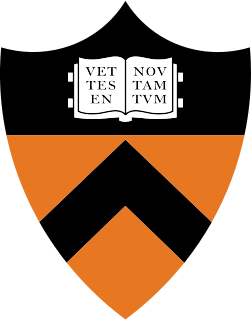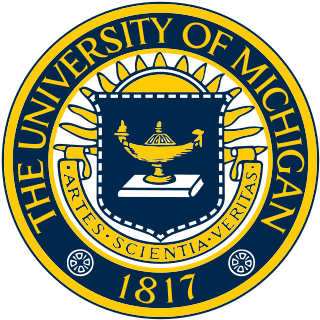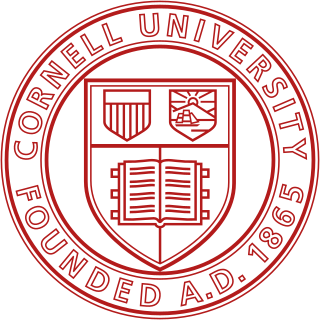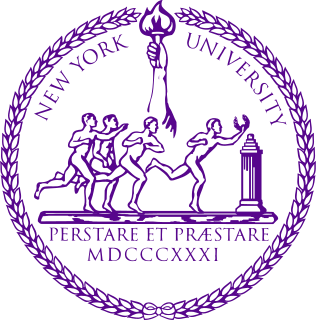Related Research Articles

Columbia University is a private Ivy League research university in New York City. Established in 1754 as King's College on the grounds of Trinity Church in Manhattan, Columbia is the oldest institution of higher education in New York and the fifth-oldest institution of higher learning in the United States. It is one of nine colonial colleges founded prior to the Declaration of Independence, seven of which belong to the Ivy League. Columbia is ranked among the top universities in the world by major education publications.

The Ivy League is an American collegiate athletic conference comprising eight private research universities in the Northeastern United States. The term Ivy League is typically used beyond the sports context to refer to the eight schools as a group of elite colleges with connotations of academic excellence, selectivity in admissions, and social elitism. Its members are Brown University, Columbia University, Cornell University, Dartmouth College, Harvard University, the University of Pennsylvania, Princeton University, and Yale University.

Princeton University is a private Ivy League research university in Princeton, New Jersey. Founded in 1746 in Elizabeth as the College of New Jersey, Princeton is the fourth-oldest institution of higher education in the United States and one of the nine colonial colleges chartered before the American Revolution. The institution moved to Newark in 1747, and then to the current site nine years later. It officially became a university in 1896 and was subsequently renamed Princeton University.

Stanford University, officially Leland Stanford Junior University, is a private research university in Stanford, California. The campus occupies 8,180 acres, among the largest in the United States, and enrolls over 17,000 students. Stanford is ranked among the best universities in the world.

Texas A&M University is a public land-grant research university in College Station, Texas. It was founded in 1876 and became the flagship institution of the Texas A&M University System in 1948. As of 2020, Texas A&M's student body is the second largest in the United States. Texas A&M is the only university in Texas to hold simultaneous designations as a land, sea, and space grant institution. It has projects funded by organizations such as the National Aeronautics and Space Administration (NASA), the National Institutes of Health, the National Science Foundation, and the Office of Naval Research. In 2001, Texas A&M was inducted as a member of the Association of American Universities. The school's students, alumni and sports teams are known as Aggies. The Texas A&M Aggies athletes compete in 18 varsity sports as a member of the Southeastern Conference.

The University of Michigan is a public research university in Ann Arbor, Michigan. Founded in 1817 by an act of the old Michigan Territory, as the Catholepistemiad, or the University of Michigania, 20 years before the territory became a state, the university is Michigan's oldest. The school was moved to Ann Arbor in 1837 onto 40 acres (16 ha) of what is now known as Central Campus. Since its establishment in Ann Arbor, the flagship university campus has expanded to include more than 584 major buildings with a combined area of more than 780 acres (3.2 km2) spread out over Central Campus and North Campus, two satellite campuses in Flint and Dearborn, and a Center in Detroit. Since the university had already been in existence for two decades before the territory earned statehood in 1837, the university was granted autonomy by the state constitution. The university has been governed by an elected board of regents independently of the state since 1850, when the state's second constitution was officially adopted. At Michigan, nearly half of the students are now from out of state.

The University of Pennsylvania is a private Ivy League research university in Philadelphia, Pennsylvania. The university, established as the College of Philadelphia in 1740, is one of the nine colonial colleges chartered prior to the U.S. Declaration of Independence. Benjamin Franklin, Penn's founder and first president, advocated an educational program that trained leaders in commerce, government, and public service, similar to a modern liberal arts curriculum with a practical perspective.

The University of Oxford is a collegiate research university in Oxford, England. There is evidence of teaching as early as 1096, making it the oldest university in the English-speaking world and the world's second-oldest university in continuous operation. It grew rapidly from 1167 when Henry II banned English students from attending the University of Paris. After disputes between students and Oxford townsfolk in 1209, some academics fled north-east to Cambridge where they established what became the University of Cambridge. The two English ancient universities share many common features and are jointly referred to as Oxbridge.

The University of California, Berkeley is a public land-grant research university in Berkeley, California. Established in 1868 as the University of California, it is the state's first land-grant university and the first campus of the University of California system. Its fourteen colleges and schools offer over 350 degree programs and enroll some 31,000 undergraduate and 12,000 graduate students. Berkeley is ranked among the world's top universities by major educational publications.

Yale University is a private Ivy League research university in New Haven, Connecticut. Founded in 1701 as the Collegiate School, it is the third-oldest institution of higher education in the United States and among the most prestigious in the world.

The University of California, Los Angeles (UCLA) is a public land-grant research university in Los Angeles, California. UCLA’s academic roots were established in 1882 as a teachers college then known as the southern branch of the California State Normal School. This school was absorbed with the official founding of UCLA as the Southern Branch of the University of California in 1919, making it the second-oldest of the 10-campus University of California system.

Sir Charles Kuen Kao was an electrical engineer and physicist who pioneered the development and use of fiber optics in telecommunications. In the 1960s, Kao created various methods to combine glass fibers with lasers in order to transmit digital data, which laid the groundwork for the evolution of the Internet.
Bachelor of Arts is a bachelor's degree awarded for an undergraduate program in the arts, or in some cases other disciplines. A Bachelor of Arts degree course is generally completed in three or four years, depending on the country and institution.
A bachelor's degree or baccalaureate is an undergraduate academic degree awarded by colleges and universities upon completion of a course of study lasting three to six years. The two most common bachelor's degrees are the Bachelor of Arts (BA) and the Bachelor of Science. In some institutions and educational systems, certain bachelor's degrees can only be taken as graduate or postgraduate educations after a first degree has been completed, although more commonly the successful completion of a bachelor's degree is a prerequisite for further courses such as a master's or a doctorate.

Cornell University is a private Ivy League and statutory land-grant research university, based in Ithaca, New York. Founded in 1865 by Ezra Cornell and Andrew Dickson White, Cornell was founded with the intention to teach and make contributions in all fields of knowledge — from the classics to the sciences, and from the theoretical to the applied. These ideals, unconventional for the time, are captured in Cornell's founding principle, a popular 1868 quotation from founder Ezra Cornell: "I would found an institution where any person can find instruction in any study."

New York University (NYU) is a private research university in New York City. Chartered in 1831 by the New York State Legislature, NYU was founded by a group of New Yorkers led by then Secretary of the Treasury Albert Gallatin.

Harvard University is a private Ivy League research university in Cambridge, Massachusetts. Founded in 1636 as Harvard College and named for its first benefactor, the Puritan clergyman John Harvard, it is the oldest institution of higher learning in the United States and among the most prestigious in the world.

A Doctor of Philosophy is the most common degree at the highest academic level awarded following a course of study. PhDs are awarded for programs across the whole breadth of academic fields. Because it is an earned research degree, those studying for a PhD are required to produce original research that expands the boundaries of knowledge, normally in the form of a thesis or dissertation, and defend their work against experts in the field. The completion of a PhD is often a requirement for employment as a university professor, researcher, or scientist in many fields. Individuals who have earned a Doctor of Philosophy degree may, in many jurisdictions, use the title Doctor with their name, although the proper etiquette associated with this usage may also be subject to the professional ethics of their own scholarly field, culture, or society. Those who teach at universities or work in academic, educational, or research fields are usually addressed by this title "professionally and socially in a salutation or conversation." Alternatively, holders may use post-nominal letters such as "Ph.D.", "PhD", or "DPhil". It is, however, considered incorrect to use both the title and post-nominals at the same time.
A Bachelor of Science is a bachelor's degree awarded for programs that generally last three to five years.

The University of Cambridge is a collegiate research university in Cambridge, United Kingdom. Founded in 1209 and granted a royal charter by Henry III in 1231, Cambridge is the second-oldest university in the English-speaking world and the world's fourth-oldest surviving university. The university grew out of an association of scholars who left the University of Oxford after a dispute with the townspeople. The two English ancient universities share many common features and are often jointly referred to as Oxbridge.
References
- ↑ "ENROLLED STUDENTS" (PDF). rzs.rs.ba. Retrieved 29 November 2019.